|
|
[Title page from the volume in my possession]
"Sa kalougata ko ira sa yalo savasava: ni ra na raica na Kalou. Maciu, Wase V.na 8"
"Blessed are the pure in heart, for they shall see God. Mat. Ch.5 v.8)"
Scripture(s) and signature in Thomas Williams's own hand, dated Nov 28th, 1859 [at which time he was minister of the Brunswick Street church in Melbourne, Australia].
|
 |
"Chart of the Fiji Islands", lithograph by Anthony La Riviere, circa 1850
|

|
"Thakombau [Cakobau], Vu-ni-valu, King of Mbau [Bau] Fiji. Copied, by permission from an original portrtait in the possession of Captain Denham, R.N. made during the Officers survey of the Fji Islands in H.M.S. Herald." |

|
"Spear heads" f.p.57 |
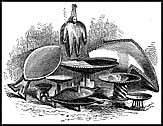
|
"Priests' bowls" p.60
[illustrating both daveniyaqona kava dishes and sedreniwaiwai oil dishes]
|
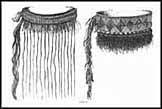
|
"Likus" f.p.67 [Liku Women's hip girdles]. |

|
"Fans and Sun-screens" p.68 |
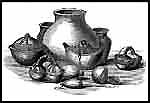
|
"Fijian pottery" p.70 |

|
"Clubs" [I-wau] f.p.77 |

|
"Priest's bowl" p.77.
This illustrates the rare priest's kava dish in duck form [daveniyaqona vakaga, or i-buburau ni bete vakaga]
|
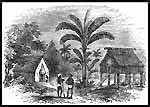
|
"Sleeping bures" p.83.
Williams wrote: "Temples, dwelling-houses, sleeping-houses, kitchens, (in Lau) inns or receiving-houses for strangers (bure ni vulagi), and yam stores, are the buildings of Fiji" p.83
|

|
Sailing canoe or camakau, p.86.
Williams wrote that, unlike the open-hulled takia or velovelo, the hull of the camakau is "completely boxed up", and "from the small resistance this build offers to the water, it is the 'clipper' of Fiji" (p.72).
[see also Haddon & Hornell, Canoes of Oceania, Honolulu, Bishop Museum Press]
|

|
"Mastheads and Pilasters of House-on-Deck of Canoes" f.p.88 |
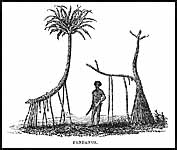
|
"Pandanus" p.98 [Illustrated is the screwpine, or Pandanus odoratissimus, in Fijian called balawa]. |

|
"Veindovi" p.102 [Veidovi, a Rewa chief] |
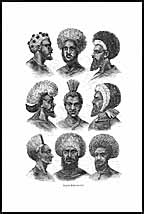
|
"Hair-Dressing" f.p.148 |

|
"Heads of Chiefs in Full Dress" f.p.156 |
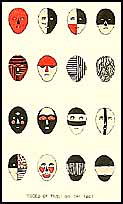
|
"Modes of Painting the face" f.p.160 |
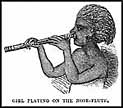
|
"Girl playing on the nose-flute" p.163 |
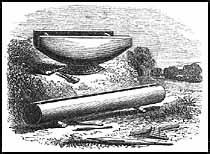
|
"Drums and musical instruments" p.164 |
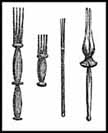
|
"Cannibal forks" p.212 [i-cula ni bokola]. |
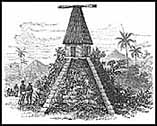
|
"Bure [temple] of Na Ututu". p.215 |

|
"Sacred stones". p.220 |
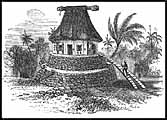
|
"Bure [temple] of Na Tavasara, Taviuni". p.222 |
|
|
"Nut tabus" p.235 |
|
|
"Takiveleyawa" p.244 |
|
|
"Savu Falls" p.253 |
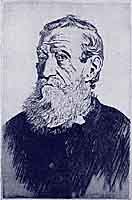 Etching of Thomas Williams by his grandson, Lionel Lindsay. [Click to enlarge]
Etching of Thomas Williams by his grandson, Lionel Lindsay. [Click to enlarge] Etching of Thomas Williams by his grandson, Lionel Lindsay. [Click to enlarge]
Etching of Thomas Williams by his grandson, Lionel Lindsay. [Click to enlarge]